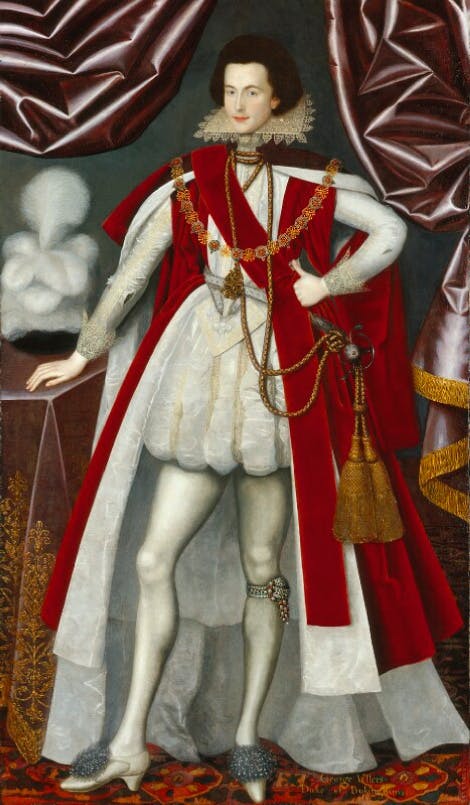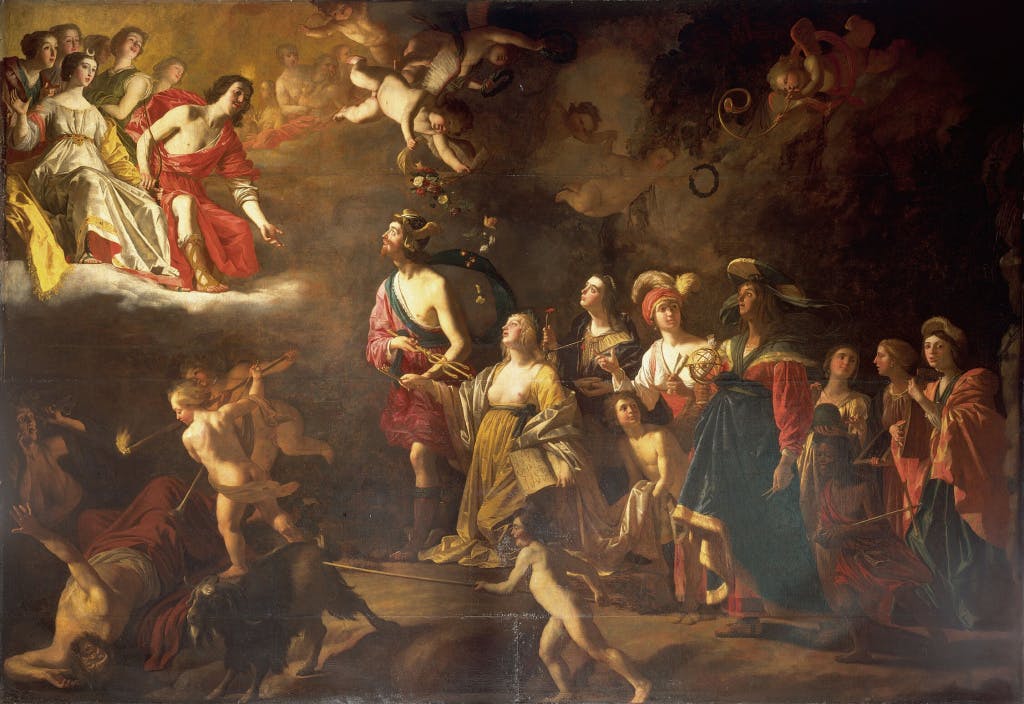The King’s Favourite: George Villiers, 1st Duke of Buckingham
Date: 01 February 2024
In the ruthless world of the Stuart court, royal favour was everything. No one knew this better than George Villiers, 1st Duke of Buckingham, whose rise to power was built on the love and patronage of King James I (VI of Scotland).
Here, Assistant Curator Minette Butler explores the life of this famous royal favourite and his place among the LGBT+ stories inside our palaces.
'The Handsomest-Bodied Man'
For one of Stuart England’s most famous men, George Villiers had relatively humble beginnings. Born in Leicestershire in 1592, he was the second son of Sir George Villiers by his second wife, Mary Beaumont.
Growing up, Villiers already showed the manners, skills and virtues needed to succeed at court, all of which he spent time polishing in France. A keen dancer and fencer, those around him recognised his grace, his charm and above all his beauty. One observer later called him ‘the handsomest-bodied man in all of England’.

Image: George Villiers, 1st Duke of Buckingham, by studio of William Larkin, c.1616. © National Portrait Gallery, London
When George Villiers Met James I and VI
Villiers first caught James I and VI’s eye at Apethorpe Palace in Northamptonshire in 1614.
James was well known for his male favourites, who he loved to shower with affection, wealth, and titles. At this time, his reigning favourite was Robert Carr, Earl of Somerset.
Carr was a powerful man who dominated the King’s affections; many people at court, including James’ wife, Queen Anne of Denmark, hoped to remove his influence. What better time for another young man to turn the King’s head?

Image: King James I of England and VI of Scotland after John De Critz the Elder, early 17th century, based on a work of c.1606. © National Portrait Gallery, London
Cupbearer and Courtier
With the help of influential allies, including his mother Mary Villiers (nee Beaumont), Countess of Buckingham and her second husband, Sir William Compton, Villiers secured the position of royal cupbearer. Serving the King as he ate, Villiers amused James with his wit and lively conversation.
Villiers also impressed James as a dancer in his spectacular court masques, one of the King’s favourite entertainments. Villiers took part in many of these elaborate performances, including masques hosted at the Banqueting House, Whitehall. Commissioned by King James, the Banqueting House was later installed with a magnificent ceiling painting dedicated to his reign.
The King’s Favourite
James’ favour soon set Villiers up for promotion, starting with a knighthood in 1615. This honour came with becoming a Gentleman of the Bedchamber, a prestigious position inside the Royal Household with exclusive access to the King as he ate and dressed.
Villiers soon displaced the Earl of Somerset as James' favourite and most trusted courtier. This privileged position allowed him to gather wealth, land, and titles for himself and his family.
In a few short years, Villiers rose from a Knight to a Viscount, an Earl, a Marquis and finally, in 1623, the Duke of Buckingham. The King also promoted him to Privy Councillor and Lord High Admiral of England.
This rising status brought other opportunities. In 1620, Villiers married Lady Katherine Manners, daughter of the influential Earl of Rutland and one of the richest women in England. This was a powerful alliance that turned into a loving marriage. The couple had four children and enjoyed the support and affection of the King.

Image: George Villiers with his wife, Lady Catherine Manners and their children. Royal Collection Trust / © His Majesty King Charles III 2024
The Lord of Heaven bless thee this morning and thy thing my daughter, and the sweet little thing that is in her belly.
Letter from James I and VI to Villiers during Lady Katherine's pregnancy, 1621
A Royal Love
Many historians consider Buckingham and James’ relationship to be an important insight into LGBT+ history – not just the story of a successful courtier.
Attitudes towards sexuality have varied throughout time, but as historians we can find evidence for same-sex relationships in the shifting language expressing romance, desire, friendship, and kinship in historical sources.
Relationships between the monarch and those around them, including their consorts, mistresses, and favourites, were as much about securing wealth and influence as companionship or desire. We’ll never know everything that happened in private between George and James, as many things were never written down, so we can't be sure if their relationship was more about love than political power.
However, we do know James loved several men throughout his life and clearly adored his beautiful, charming young favourite. This was a connection that Buckingham worked hard to maintain, both out of his own fondness for the King and to protect his privileged position.
Accounts of the two men’s lives reveal a tender, affectionate relationship. James openly doted on Villiers and in 1617, he toasted him before the court, explaining that ‘I love the Duke of Buckingham more than any other man’. The King justified this through his faith, stating that ‘Christ had his John and I have my George’.

Image: Equestrian Portrait of the Duke of Buckingham by Peter Paul Rubens, 1625. Oil on panel, 18 3/8 x 20 3/8 in. (46.6 x 51.7 cm), Framed: 27 1/2 x 29 3/8 x 2 3/8 in. (69.9 x 74.6 x 6 cm), AP 1976.08. Kimbell Art Museum, Fort Worth, Texas
I never saw a fond husband make so much or so great a dalliance over his beautiful spouse as I have seen King James over his favourites, especially the Duke of Buckingham.
Sir John Oglander, 1617
Privately, James’ letters to Buckingham are warm, vulnerable, and revealing. The King called Villiers ‘Steenie’, shortened from St Stephen, who was said to have the face of an angel. He also referred to his favourite as his ‘sweet child’ and ‘wife’. In one letter, Buckingham reminisced about a night spent at Farnham in Surrey, where the two men lay so close together that ‘the bed’s head could not be found between the master and his dog’.

Image: King James I of England and VI of Scotland, by Daniel Mytens, 1621. © National Portrait Gallery, London
I desire only to live in this world for your sake, and that I had rather live banished in any part of the earth with you than live a sorrowful widow’s life without you. And so God bless you, my sweet child and wife, and grant that ye may ever be a comfort to your dear dad and husband.
Letter from James I and VI to George Villiers, 1623
Long Live the King
James I and VI died in 1625. But even with his patron gone, Villiers hung on to power. He forged a friendship with James’ son and successor Charles I, becoming the new King’s close confidant.

Image: George Villiers, 1st Duke of Buckingham c.1628-9. Royal Collection Trust / © His Majesty King Charles III 2024
Today, you can find a testament to Charles I and Buckingham’s relationship towering above the Queen’s Staircase at Hampton Court Palace. An enormous painting by Dutch artist Gerrit van Honthorst depicts Villiers and a woman, possibly his wife, Lady Katherine Manners, paying homage to Charles and his Queen, Henrietta Maria.
Handsome and bare-chested, Buckingham’s esteemed place at the heart of the monarchy remains on full display in lavish, classical splendour. The painting is still a must-see on a Queer walk around Hampton Court Palace.
A fascinating figure from the Stuart court, Buckingham’s story reveals both the machinations necessary to get close to the crown and the personal passions at the heart of the monarchy.
Minette Butler
Assistant Curator, Historic Royal Palaces

More from our blog

Frances Stuart and Barbara Villiers
10 February 2023
Learn about the relationship between Frances Stuart and Barbara Villiers, two of the most influential women at the court of King Charles II.

Charles II's Coronation Procession from the Tower of London
24 April 2023
Curator of Historic Buildings, Alden Gregory, takes a look at Charles II's Coronation - the last coronation in which the Tower of London played a starring role.

A Queer Walk through Hampton Court Palace
11 February 2021
When you next visit Hampton Court, bring a queer eye to the palace. Shift your perception. Actively look around you. I promise there is a rich history to find.

